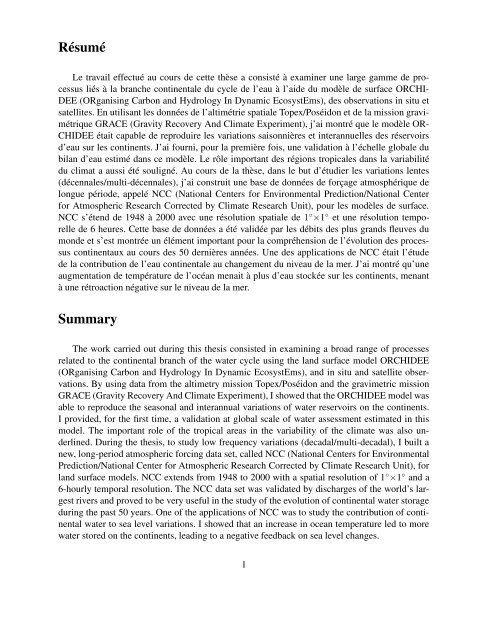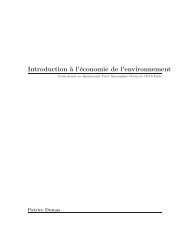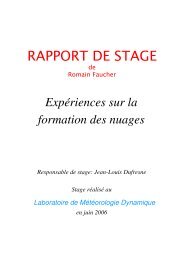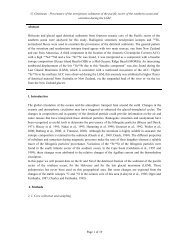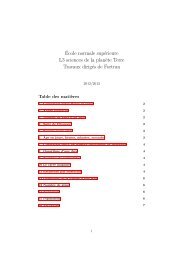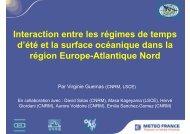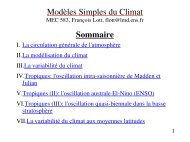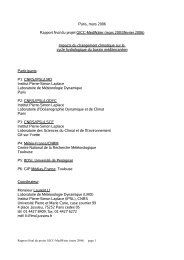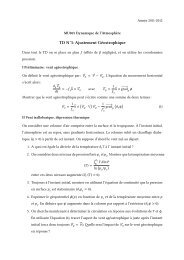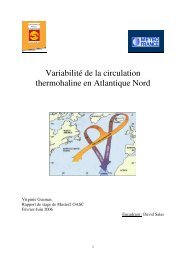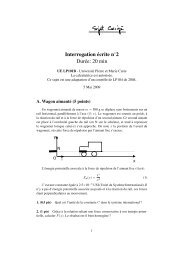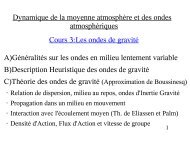variabilité interannuelle et tendances. Comparaison aux ... - LMD
variabilité interannuelle et tendances. Comparaison aux ... - LMD
variabilité interannuelle et tendances. Comparaison aux ... - LMD
Create successful ePaper yourself
Turn your PDF publications into a flip-book with our unique Google optimized e-Paper software.
Résumé<br />
Le travail effectué au cours de c<strong>et</strong>te thèse a consisté à examiner une large gamme de processus<br />
liés à la branche continentale du cycle de l’eau à l’aide du modèle de surface ORCHI-<br />
DEE (ORganising Carbon and Hydrology In Dynamic EcosystEms), des observations in situ <strong>et</strong><br />
satellites. En utilisant les données de l’altimétrie spatiale Topex/Poséidon <strong>et</strong> de la mission gravimétrique<br />
GRACE (Gravity Recovery And Climate Experiment), j’ai montré que le modèle OR-<br />
CHIDEE était capable de reproduire les variations saisonnières <strong>et</strong> <strong>interannuelle</strong>s des réservoirs<br />
d’eau sur les continents. J’ai fourni, pour la première fois, une validation à l’échelle globale du<br />
bilan d’eau estimé dans ce modèle. Le rôle important des régions tropicales dans la <strong>variabilité</strong><br />
du climat a aussi été souligné. Au cours de la thèse, dans le but d’étudier les variations lentes<br />
(décennales/multi-décennales), j’ai construit une base de données de forçage atmosphérique de<br />
longue période, appelé NCC (National Centers for Environmental Prediction/National Center<br />
for Atmospheric Research Corrected by Climate Research Unit), pour les modèles de surface.<br />
NCC s’étend de 1948 à 2000 avec une résolution spatiale de 1 ◦ ×1 ◦ <strong>et</strong> une résolution temporelle<br />
de 6 heures. C<strong>et</strong>te base de données a été validée par les débits des plus grands fleuves du<br />
monde <strong>et</strong> s’est montrée un élément important pour la compréhension de l’évolution des processus<br />
continent<strong>aux</strong> au cours des 50 dernières années. Une des applications de NCC était l’étude<br />
de la contribution de l’eau continentale au changement du niveau de la mer. J’ai montré qu’une<br />
augmentation de température de l’océan menait à plus d’eau stockée sur les continents, menant<br />
à une rétroaction négative sur le niveau de la mer.<br />
Summary<br />
The work carried out during this thesis consisted in examining a broad range of processes<br />
related to the continental branch of the water cycle using the land surface model ORCHIDEE<br />
(ORganising Carbon and Hydrology In Dynamic EcosystEms), and in situ and satellite observations.<br />
By using data from the altim<strong>et</strong>ry mission Topex/Poséidon and the gravim<strong>et</strong>ric mission<br />
GRACE (Gravity Recovery And Climate Experiment), I showed that the ORCHIDEE model was<br />
able to reproduce the seasonal and interannual variations of water reservoirs on the continents.<br />
I provided, for the first time, a validation at global scale of water assessment estimated in this<br />
model. The important role of the tropical areas in the variability of the climate was also underlined.<br />
During the thesis, to study low frequency variations (decadal/multi-decadal), I built a<br />
new, long-period atmospheric forcing data s<strong>et</strong>, called NCC (National Centers for Environmental<br />
Prediction/National Center for Atmospheric Research Corrected by Climate Research Unit), for<br />
land surface models. NCC extends from 1948 to 2000 with a spatial resolution of 1 ◦ ×1 ◦ and a<br />
6-hourly temporal resolution. The NCC data s<strong>et</strong> was validated by discharges of the world’s largest<br />
rivers and proved to be very useful in the study of the evolution of continental water storage<br />
during the past 50 years. One of the applications of NCC was to study the contribution of continental<br />
water to sea level variations. I showed that an increase in ocean temperature led to more<br />
water stored on the continents, leading to a negative feedback on sea level changes.<br />
1


